Western Digital has expanded their Red line to include an 8TB model, increasing the maximum capacity of 8-bay NAS units to 64TB so that SOHO users can get even more out of their initial server investment. WD is using their HelioSeal helium-technology to get the higher capacity much like the HGST Ultrastar Helium Drives. WD Reds still make use of NASware 3.0, which Western Digital originally released alongside the 6TB model to expand drive compatibility, allowing users to load Red drives into 8-bay servers (they were previously only recommended up to 5 bays). NASware 3.0 also improved the reliability and performance of Red drives, optimizing them for NAS environments in which downtime can be devastating.
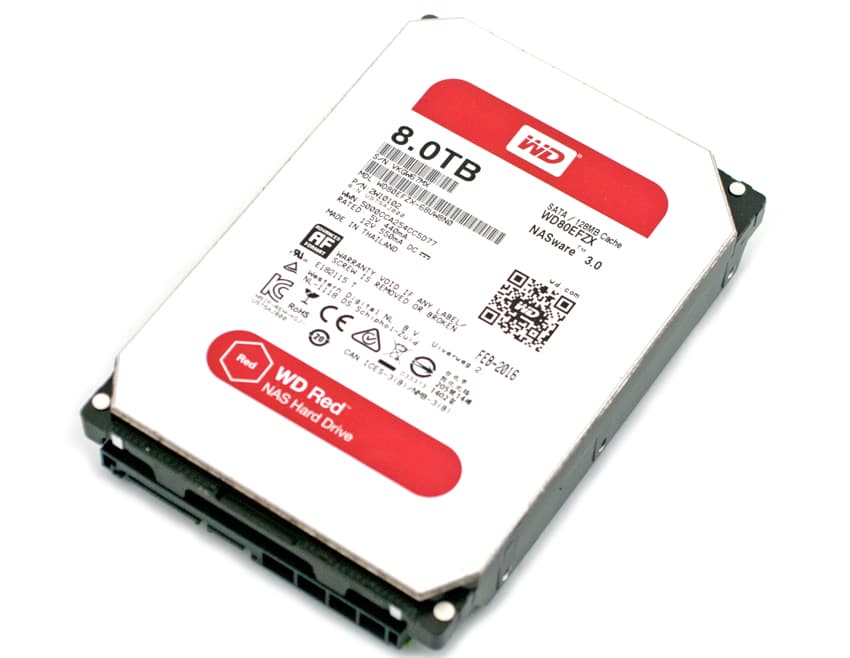
It is important to distinguish these drives from standard desktop drives; while desktop drives might initially function similarly, their reliability would likely deteriorate in the always-on NAS environment. Since desktop drives tend to operate isolated from other drives, they aren’t typically built to withstand the constant vibrations inherent to a multi-drive system. Using a NAS-optimized drive like the WD Red will give users a more consistent and reliable performance. WD Reds were also designed to thrive in SMB and RAID environments while consuming minimal energy, subsequently producing less heat. Loading an 8-bay NAS with standard desktop drives would cause significant overheating, potentially damaging the drives as well as the NAS itself.

Although WD Reds can be used with almost any small NAS on the market, WD claims that users will see ultimate compatibility and performance if they load them into a My Cloud NAS (specifically, the My Cloud, the 2-bay My Cloud EX2, and the 4-bay My Cloud EX4). The 8TB model costs $379.99, and all of the Red drives carry a 3-year warranty.
Specifications
- Capacities
- 1TB (WD10EFRX)
- 2TB (WD20EFRX)
- 3TB (WD30EFRX)
- 4TB (WD40EFRX)
- 5TB (WD50EFRX)
- 6TB (WD60EFRX)
- 8TB (WD80EFRX)
- Interface: SATA 6Gb/s
- Form Factor: 3.5in
- RPM: 5400
- Cache: 128MB
- Advanced Format
- Native command queuing
- RoHS compliant
- Data transfer rate (max)
- Buffer to host 6Gb/s
- Power Management
- 12VDC-/+10% (A, peak): 1.79
- Temperature (°C)
- Operating: 0 to 65
- Non-operating: -40 to 70
- Shock (Gs)
- Operating (2ms, read/write): 30
- Operating (2ms, read): 65
- Non-operating (2ms): 250
- Acoustics (dBA)
- Idle: 20
- Seek (average): 29
- Physical Dimensions
- Height (in/mm, max) 1.028/26.1
- Length (in/mm, max) 5.787/147
- Width (in/mm, ± .01in) 4/101.6
- Weight (lb/kg, ± 10%) 1.43/0.65
- Warranty: 3 years
Enterprise Synthetic Workload Analysis
Our enterprise hard drive benchmark process preconditions each drive into steady-state with the same workload the device will be tested with under a heavy load of 16 threads with an outstanding queue of 16 per thread, and then tested in set intervals in multiple thread/queue depth profiles to show performance under light and heavy usage. Since hard drives reach their rated performance level very quickly, we only graph out the main sections of each test.
Preconditioning and Primary Steady-State Tests:
- Throughput (Read+Write IOPS Aggregate)
- Average Latency (Read+Write Latency Averaged Together)
- Max Latency (Peak Read or Write Latency)
- Latency Standard Deviation (Read+Write Standard Deviation Averaged Together)
Our Enterprise Synthetic Workload Analysis includes four profiles based on real-world tasks. These profiles have been developed to make it easier to compare to our past benchmarks as well as widely-published values such as max 4k read and write speed and 8k 70/30.
- 4k
- 100% Read or 100% Write
- 100% 4k
- 8k 70/30
- 70% Read, 30% Write
- 100% 8k
- 128k (Sequential)
- 100% Read or 100% Write
- 100% 128k
In the following section of this review, we will show the performance of both iSCSI and CIFS configurations of the new 3.5″ WD Red 8TB HDDs. WD supplied StorageReview with 8 samples of their new HDDs, which we configured in RAID10 in our Synology DiskStation DS1815+.
We will be including the following drives as comparables in the same DS1815+ configuration:
Looking at throughout in our first test measuring 4K random performance (CIFS), all of the numbers were in the same ballpark, but the WD Red drives were slightly outperformed in both read and write throughput (593 IOPS and 1628 IOPS, respectively). The Seagate NAS drives performed the best in terms of write throughput (2,246 IOPS), and they had roughly the same read performance as the Seagate Enterprise NAS drives (651 IOPS).
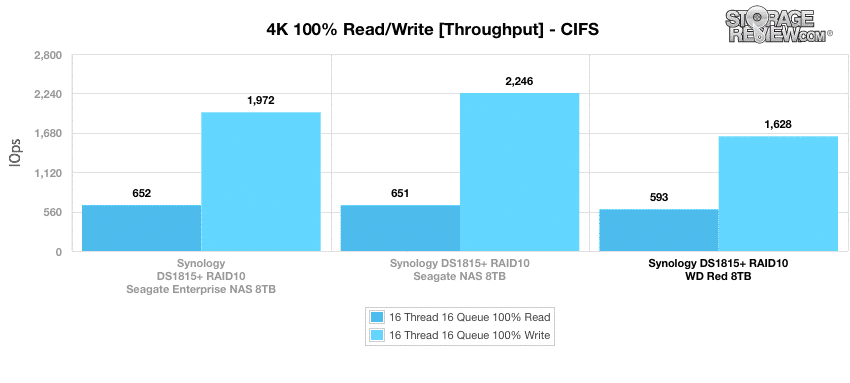
Running the same benchmark with the drives configured in iSCSI yielded similar results; the WD Red drives posted lower numbers, in both read and write (2,602 IOPS and 1,476 IOPS, respectively), than the Seagate NAS drives (3,191 IOPS and 1,646 IOPS, respectively).
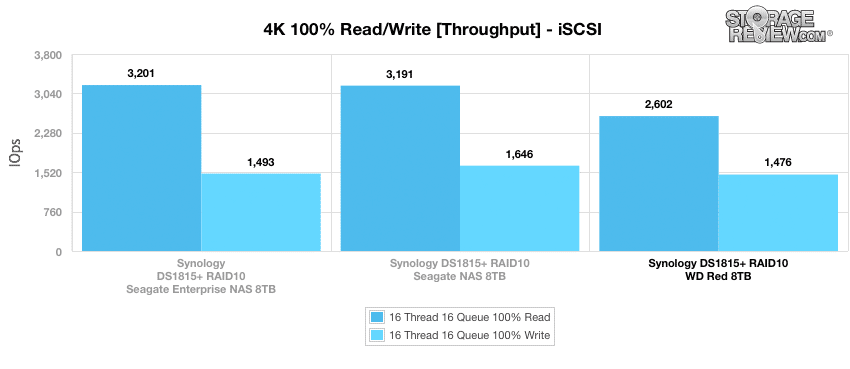
The standings of the average latency benchmark (CIFS) are consistent with the results of the throughput benchmark, with the WD Red drives slightly lagging behind the other drives (431.54ms read and 157.193ms write). The Seagate NAS drives and Seagate Enterprise NAS drives posted very similar numbers in both read and write (roughly 390ms and 115ms, respectively).
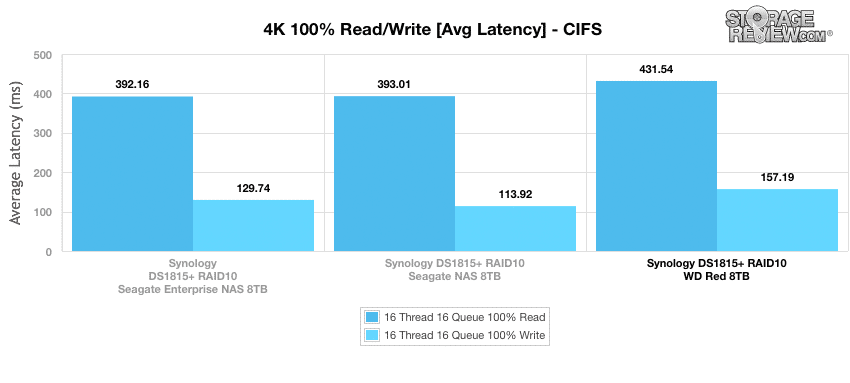
Once again, the results were similar when the drives were configured in iSCSI; although the numbers were close, the WD Red drives (98.35ms read and 173.3ms write) were outperformed by the Seagate NAS drives (80.2ms read and 155.5ms write).
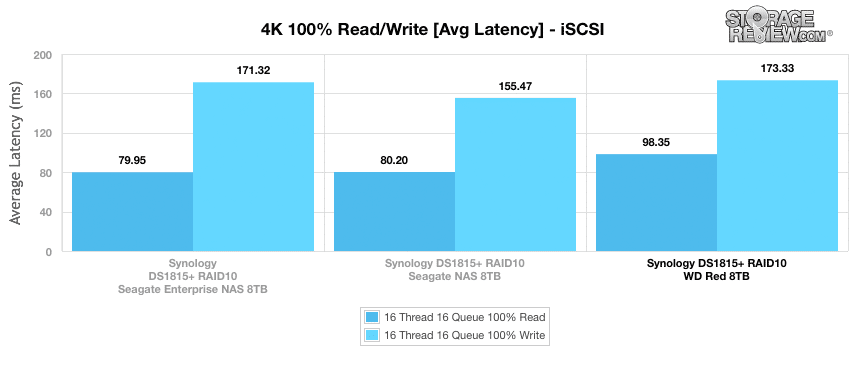
In the max latency benchmark (CIFS), the WD Red drives posted 2,712ms read and 3,186ms write, and the Seagate NAS drives posted 2,363ms read and 3,063ms write.
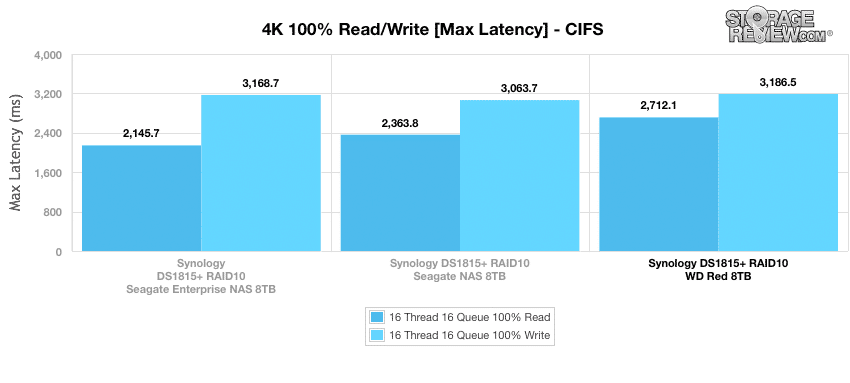
In the iSCSI configuration of the max latency benchmark, the WD Red drives demonstrated an improvement in write performance compared to previous benchmarks, outperforming both of the other drives with 826.7ms. However, its read performance (933.2ms) was less impressive compared to the other drives.
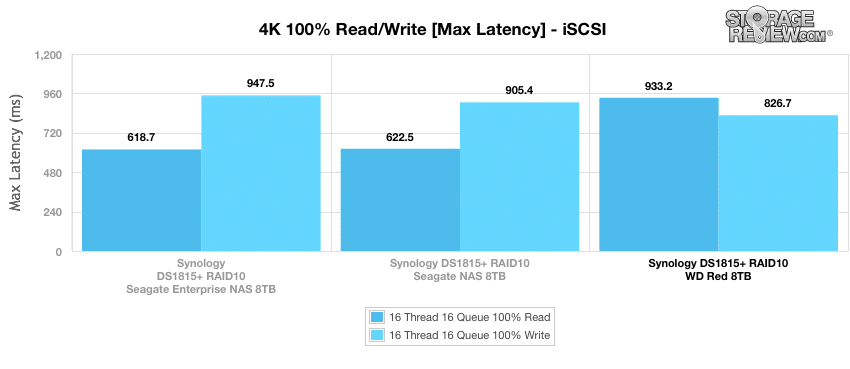
The WD Red exhibited a more consistent write performance (CIFS) than the Seagate Enterprise NAS drives (191ms vs. 197ms, respectively), but less consistent than the Seagate NAS drives (167ms). In terms of read function, the WD Red drives were handedly outperformed by the Seagate NAS drives (591ms vs. 462ms, respectively).
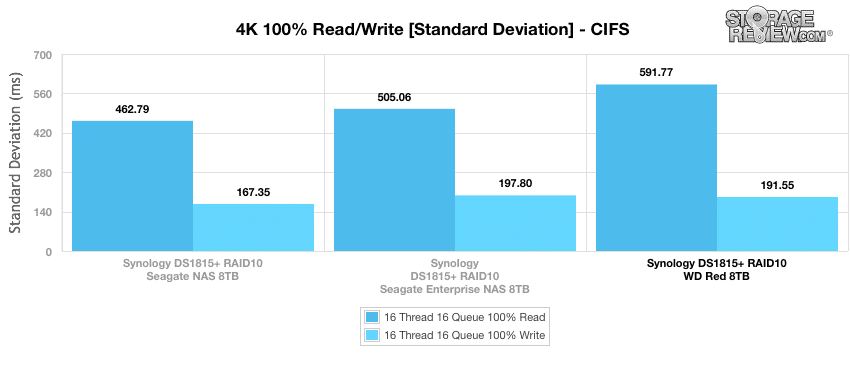
In the iSCSI configuration, the WD Red drives were in line with the Seagate Enterprise NAS drives in terms of write function (130ms) but fell short compared to the Seagate NAS drives (121ms). The WD Red drives were outperformed in terms of read function (105ms) compared to the other drives tested.
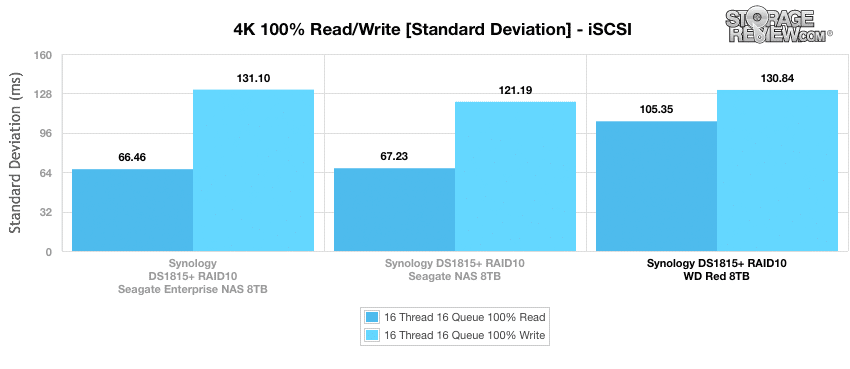
Our next benchmark measures 100% 8K sequential throughput with a 16T/16Q load in 100% read and 100% write operations. The WD Red drives kept up with the other drives for the most part, posting 55,137 IOPS read and 34,183 IOPS write. The Seagate NAS drives had slightly higher numbers, with 55,273 IOPS read and 39,453 IOPS write.
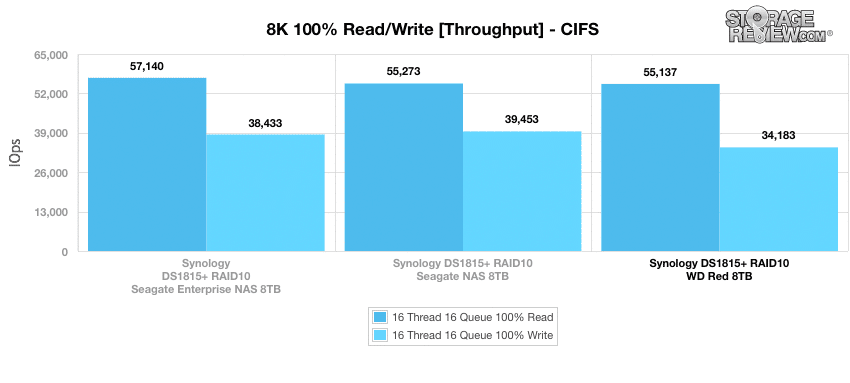
Although the WD Red drives performed well with write functions in the iSCSI configuration of our 8k sequential benchmark (18,227 IOPS), it fells short with read functions (16,340 IOPS). The Seagate Enterprise NAS drives posted the highest read performance (30,677 IOPS).
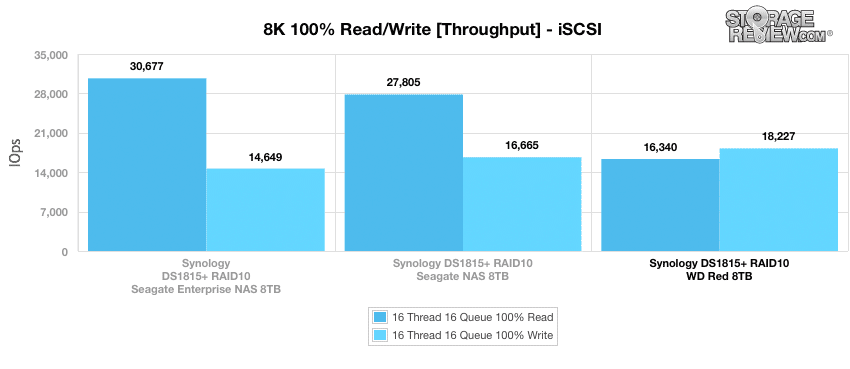
Compared to the fixed 16 thread, 16 queue max workload we performed in the 100% 4k write test, our mixed workload profiles scale the performance across a wide range of thread/queue combinations. In these tests, we span workload intensity from 2 threads and 2 queue up to 16 threads and 16 queue. All of the drives that we tested in CIFS performed similarly, although the Seagate NAS drives posted higher numbers for the most part, and the WD Red drives performed on the lower end of the spectrum.
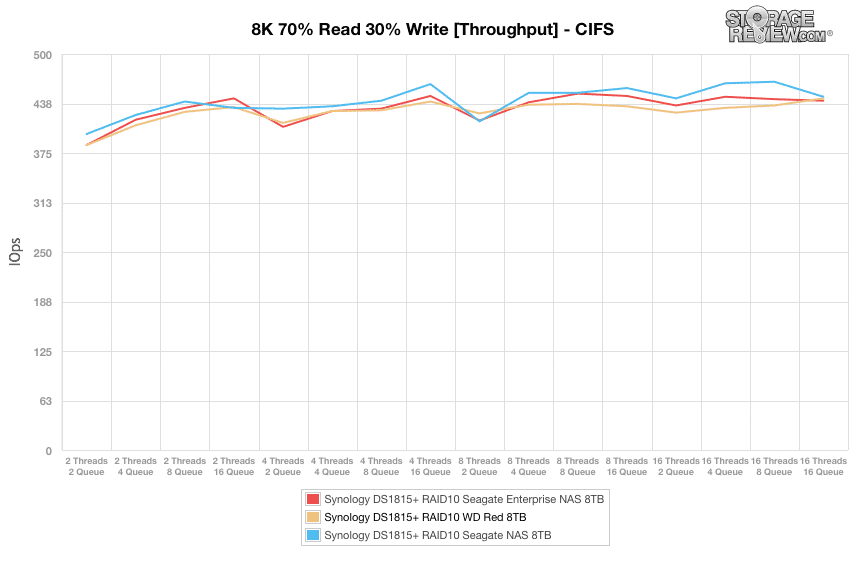
The results were similar in the iSCSI configuration; the WD Red drives were outperformed by both the Seagate NAS drives and the Seagate Enterprise NAS drives.
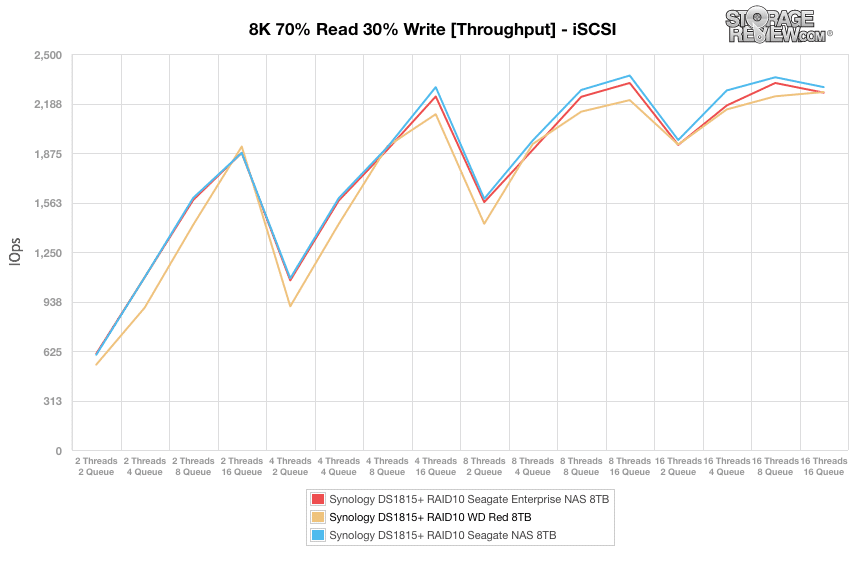
We saw consistent results in the CIFS configuration of our average latency benchmark, with the WD Red drives performing slightly slower than the others and the Seagate NAS drives performing slightly faster.
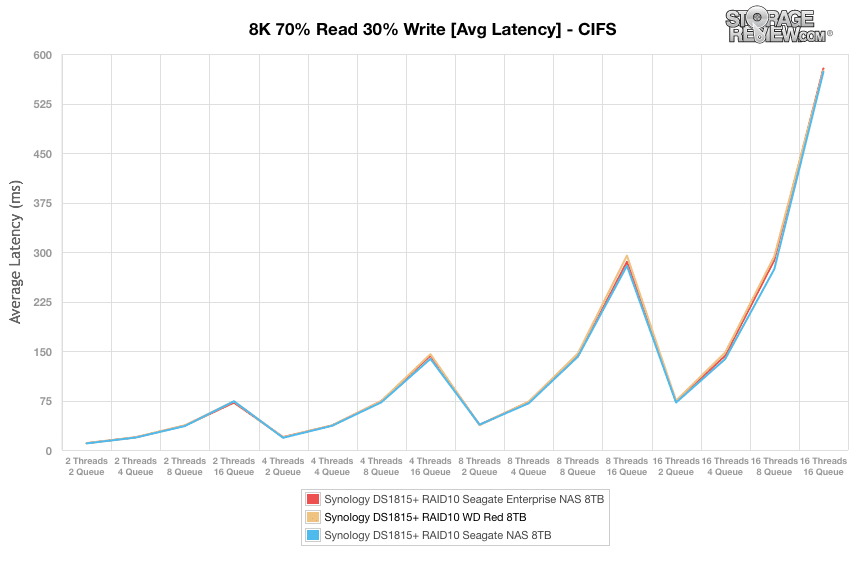
In our latency benchmark (iSCSI), the WD Red drives were slightly behind the others in terms of average latency, although there was only a slight difference in performance across the board.
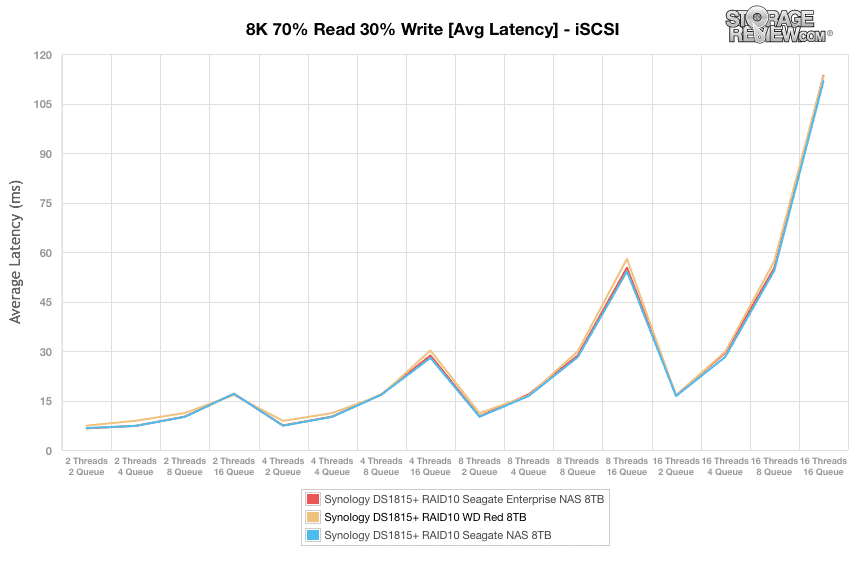
The results of our max latency benchmark (CIFS) were scattered, but the WD Red drives posted lower latencies than the other drives for the most part. The Seagate NAS drives fell behind in this benchmark, especially towards the end.
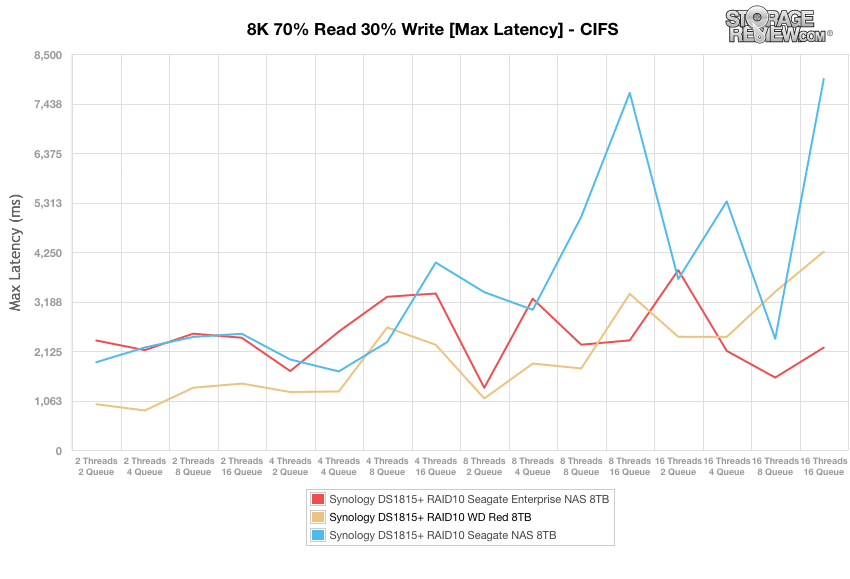
The Seagate NAS drives were the top performers in the iSCSI configuration of our max latency benchmark. The WD Red drives and Seagate Enterprise NAS drives exhibited marginal differences in performance.
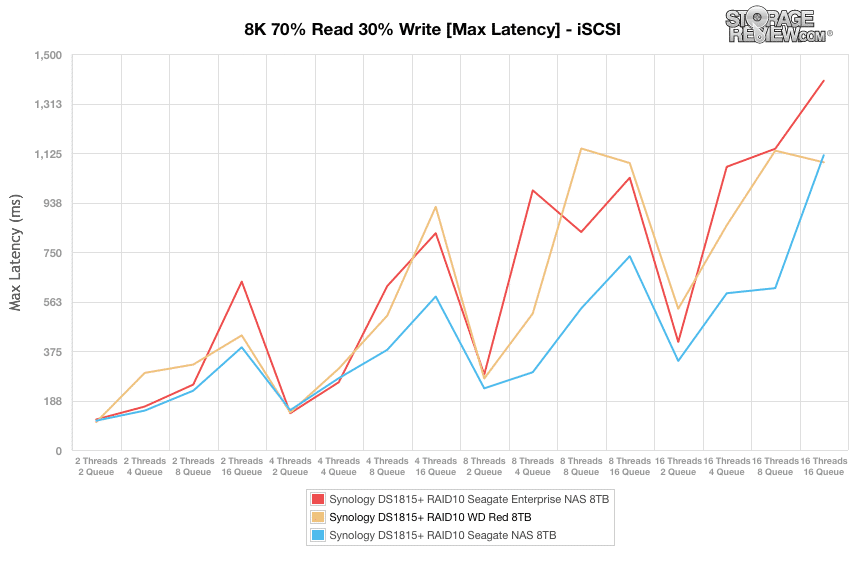
The WD Red drives performed well in the standard deviation benchmark (CIFS), leading the other drives until the end. The Seagate NAS drives and Seagate Enterprise NAS drives were mostly neck and neck for the duration of the benchmark.
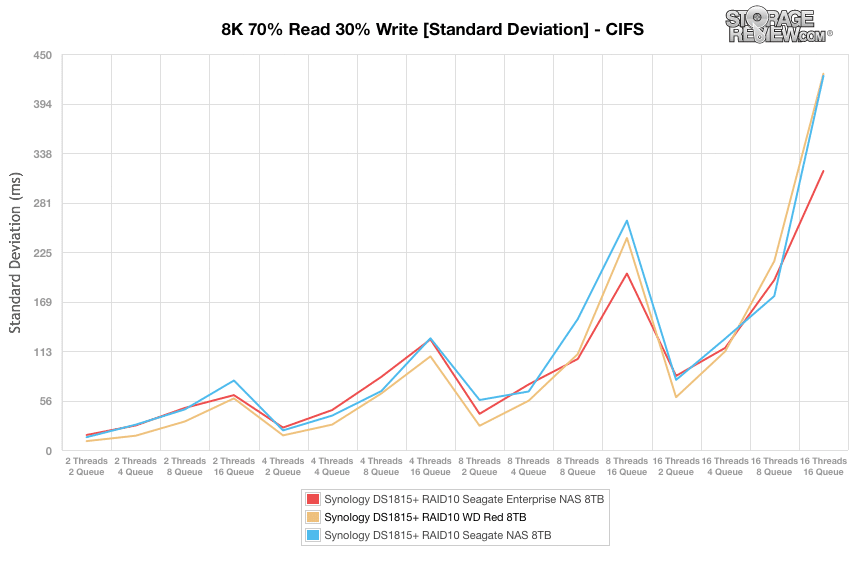
Although the WD Red drives were in line with the others towards the beginning of our standard deviation benchmark (iSCSI), they fell behind towards the end.
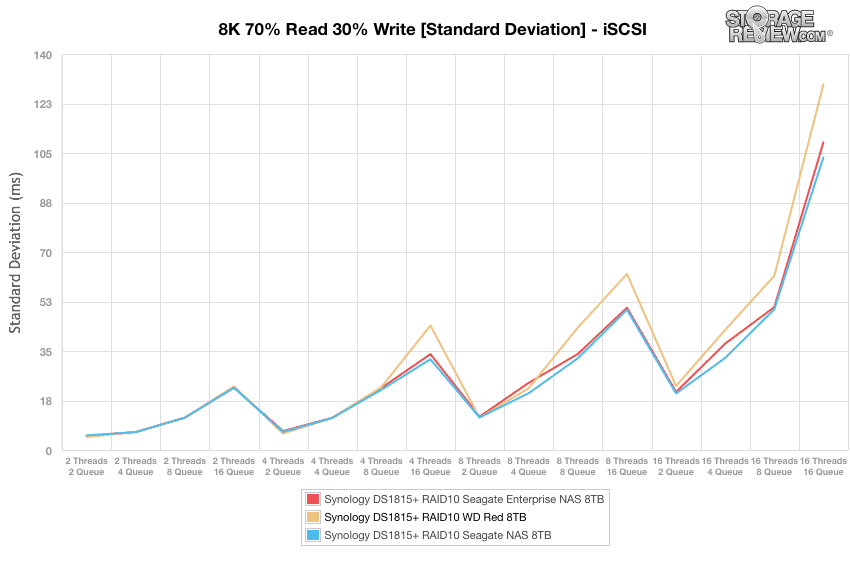
The last test in our Enterprise Synthetic Workload testing is the 128k test, which is a large block sequential test that shows the highest sequential transfer speed for a platter drive. Looking at the 128k performance of 100% write and 100% read activity (CIFS), all three drives shared similar numbers, especially in read functions (roughly 462,470 IOPS). There was some slight variation in write functions, with the Seagate NAS drives leading (443,107 IOPS) and the WD Red drives posting 439,876 IOPS.
Read performance was similar among all drives tested (460,000 IOPS), but the WD Red drives posted a write performance (172,000) that was significantly below the other drives.
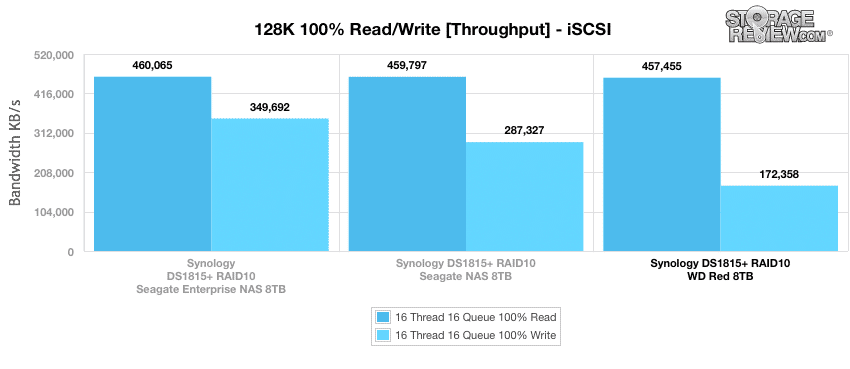
Conclusion
The new 8TB Red HDD allows users to expand their current raw capacity without adding NAS bays. Loading an 8-bay NAS with the 8TB drives would effectively provide 16TB of additional storage space (over 6TB drives). The new Red drives use Western Digital’s NASware 3.0, which optimizes the HDDs for use in a NAS environment. Loading a server with regular desktop drives, which aren’t designed to withstand the vibrations of neighboring drives, would reduce performance. Using the new HelioSeal helium-technology, the WD Red drives are also built to be efficient, resulting in energy savings for the user, as well as reduced heat production, this in itself can be a huge advantage over traditional NAS drives.
In terms of performance, the WD Red drives performed well compared to the Seagate NAS drives, considering the spindle speed disadvantage (5,400 RPM vs. 7,200 RPM). Although the Seagate NAS drives outperformed the WD Reds in most benchmarks, the margins were small. The two drives were more or less in the same ballpark, especially when configured in iSCSI. Our 4K throughput gave us a write performance of 1,628 IOPS (CIFS) and a read performance of 2,602 IOPS (iSCSI). The WD Red NAS drive showed stronger performance in our 8K iSCSI with a top write score of 18,227 IOPS. The WD stay neck and neck with the Seagate drives in our 128K large block CIFS test (462MB/s read and 443MB/s write), it fell behind the other drives in iSCSI, particularly in writes with a score of 172MB/s over 100MB/s beneath the next closest drive. While performance was slightly under the Seagate, WD gives enough performance for most use cases while saving on energy and delivering quieter system performance thanks to improved drive thermals.
Pros
- Lower energy usage than a traditional drive
- Optimized for NAS use
- Good performance overall
Cons
- Trailed slightly behind competitive drive in most tests
The Bottom Line
The WD Red 8TB model is a great addition to Western Digital’s Red line, building sealed drive technology into a well known platform to deliver a compelling overall value proposition.
Discuss this review


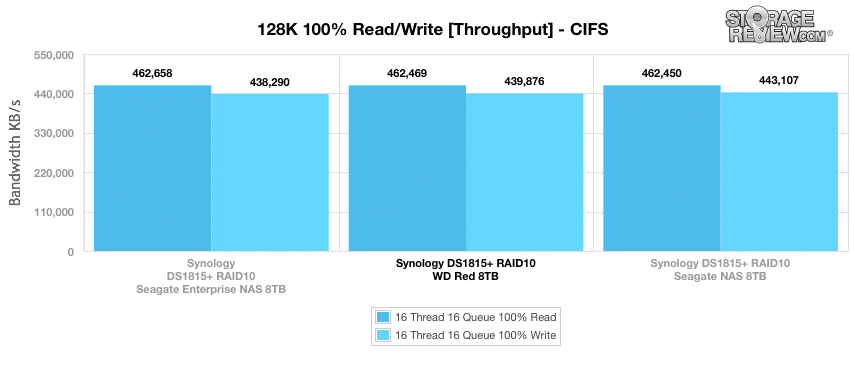


 Amazon
Amazon